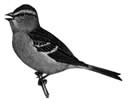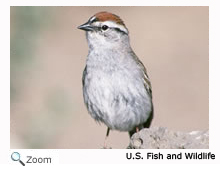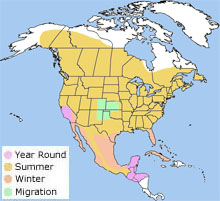Chipping Sparrow - Spizella passerina |
|||||||||||
Description
Range | HabitatThe chipping sparrow is found in a variety of habitats including open woodlands, marshes, deserts, fields, gardens, and farmland. DietThe chipping sparrow eats seeds, berries, and insects. Life Cycle
The male chipping sparrow arrives at the breeding grounds first. He aggressively protects his territory. The female lays 4-6 eggs in a cup-shaped nest made of sticks, grass, and moss. The nest is made on the ground. The female incubates the eggs. Incubation takes about 12 days. Both the male and female care for and feed the chicks. The chicks fledge when they are about two weeks old, but they continue to be fed by their parents for a few more weeks. Behavior The chipping sparrow migrates at night. |
||||||||||
Audio Credit: xeno-canto.org Chris Parrish |
|||||||||||



 The chipping sparrow is found in most of the United States, Canada, and Mexico.
The chipping sparrow is found in most of the United States, Canada, and Mexico.